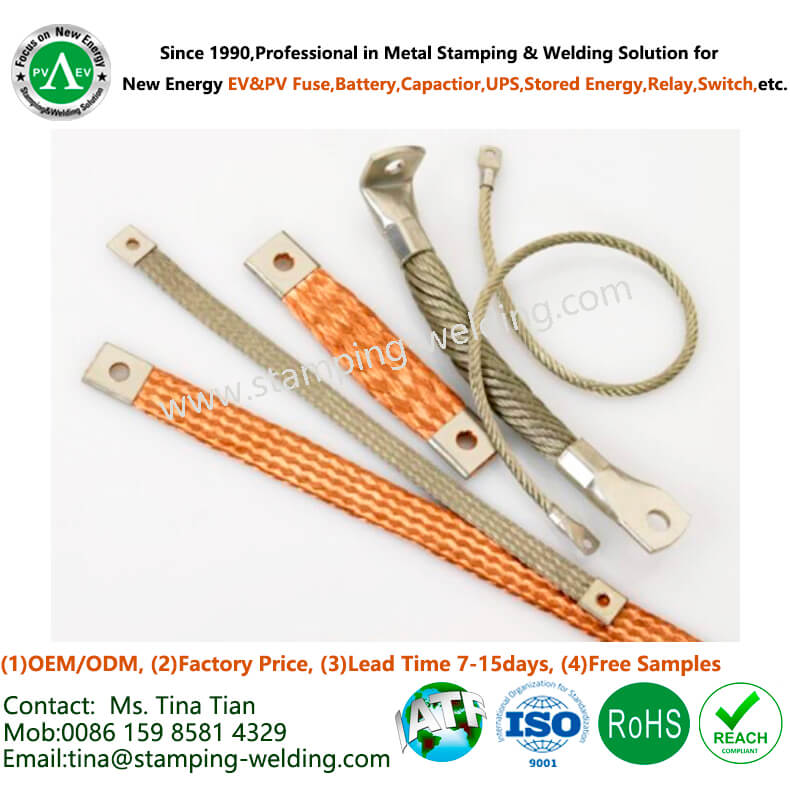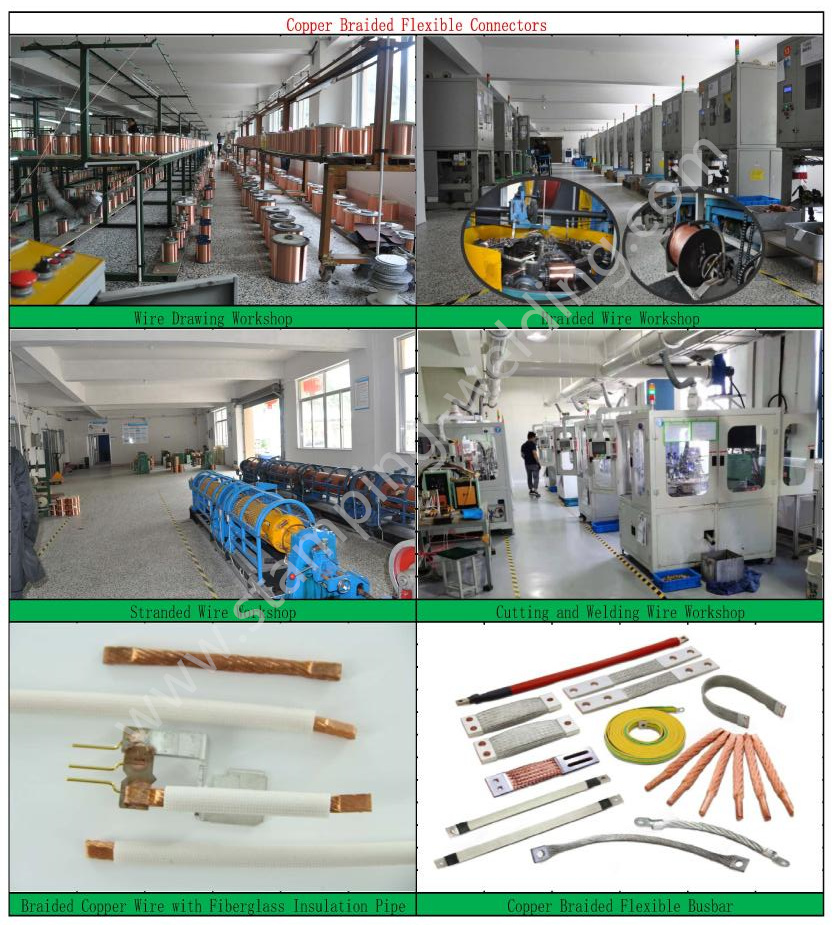

1- Products Name: Flexible Copper Braid Wire
2- Base Material Standard:
GB: T2Y2 Copper Braided Wire or Copper Stranded Wire
(2.1) The joints at both ends are crimped with high-quality copper pipes or copper lug terminals;
(2.2) Single layer 1.5mm2—150mm2 (multi-layer braided wire can be customized
DIN: E-Cu58 (Number: 2.0065)
EN: Cu-ETP ( Number: CW004A)
ISO: Cu-ETP
UNS: C11000
JIS: C1100
BS: C101
Purity ≥99.99% Copper, Conductivity %IACS≥97, Hardness 80~110HV, Tensile Strength 245-345MPa, other material also can be customized.
3-Surface Treatments:
(3.1) Silver plating
(3.2) Tin plating
(3.3) Nickel plating or Resistance diffusion welding nickel sheet
(3.4) Ultrasonic cleaning
Normally plated thickness is 3μm to 12μm, but all upon customers' request.
4- Insulation Options:
(4.1) PET insulation paper (brands USA GTS, GERMANY KREMPEL, etc with white or milky white colors)
(4.2) PVC dipping (orange and green are the most popular colors)
(4.3) Epoxy powder coating (orange, green and grey are the most popular colors)
(4.4) PE heat shrink tube (orange, green, black, red are yellow are the most popular colors)
(4.5) PA66 plastic housing (white, grey etc are the most popular colors)
Flame Retardant / Fire Resistance: UL94-V-0 or upon you request;
Operating Temperature: -45ºC to +150 ºC
5- Copper Busbar Resistance: ≤0.00001Ω
6- Copper Busbar load voltage 3500VDC to 5000VDC and current 100A to 2000A
7- Copper Busbar Assembly Fixtures: USA PEM stainless nuts, studs, standoffs, screws, etc
8- Free Samples:1-10pcs is allowed
9- Lead Time:Orders 7-10days,Samples 10-20days(including the tooling/die production of Copper Stamped Part);
10- Packing: pearl cotton/blister box inside and carton/pallet outside
11- Certifications: ISO9001, IATF16949, RoHS, REACH, etc.
12- Production Capacity: 50,000,000 pcs/month
13- Applications: film capacitors for new energy electric vehicles and hybrid vehicles, new energy vehicle battery packs, new energy photovoltaic energy storage, power appliances, distribution cabinets, rail transit, cloud server uninterruptible power supplies and other power systems.
The manufacturing process of flexible copper braid wire involves several steps to create a durable and flexible electrical conductor. The flexible nature of copper braid wires makes them suitable for various applications where movement, flexibility, and vibration resistance are required. Here is a general overview of the manufacturing process:
1.Raw Material Selection:
The process begins with the selection of high-quality copper wire as the raw material. The copper used is typically of high conductivity to ensure optimal electrical performance.
2.Wire Drawing:
The selected copper wire undergoes a wire drawing process where it is pulled through a series of dies to reduce its diameter. This process helps in achieving the desired thickness and flexibility for the copper braid wire.
3.Stranding or Braiding:
The Flexible Braided copper wire is then either stranded or braided to create the flexible structure of the braid wire.
Stranding: In stranding, multiple thin copper wires are twisted or grouped together. This enhances flexibility and allows the wire to bend without breaking.
Braiding: In braiding, individual strands of copper are intertwined to form a braided pattern. This design offers flexibility and additional surface area for improved conductivity.
4.Annealing:
The stranded or braided copper wire is subjected to an annealing process. Annealing involves heating the wire and then allowing it to cool slowly. This process helps relieve internal stresses and improves the flexibility and conductivity of the wire.
5.Tinning (Optional):
In some cases, the copper braid wire may undergo a tinning process where a thin layer of tin is applied to the surface. Tinning provides additional corrosion resistance and can improve solderability.
6.Quality Control:
Throughout the manufacturing process, quality control measures are implemented to ensure that the copper braid wire meets the required specifications. This may involve testing for conductivity, flexibility, and other mechanical properties.
7.Cutting and Termination:
The continuous length of flexible copper braid wire is cut into specific lengths according to customer requirements. Terminals or connectors may be added to the ends of the braid wire through crimping, welding, or other termination methods.
8.Insulation (Optional):
Depending on the application, the flexible copper braid wire may be insulated with materials such as PVC, rubber, or other insulating materials. Insulation provides protection against environmental factors and enhances safety.
9.Final Inspection:
The finished flexible copper braid wires undergo a final inspection to ensure that they meet the desired standards and specifications. This includes checking for proper dimensions, flexibility, and electrical performance.
10.Packaging:
The completed copper braid wires are packaged and prepared for shipment to customers. Proper packaging helps protect the wires during transportation and storage.
It's important to note that specific manufacturing processes may vary among different manufacturers, and the steps mentioned above provide a general overview of the typical production of flexible copper braid wire. Manufacturers may tailor the process to meet the specific requirements of different industries and applications.

Contact Information:
Ms.Tina Tian (Sales Manager&Technology Engineer)
Xiamen Apollo Stamping Welding Technology Co., Ltd
Apollo Electronic Components (Xiamen) Co.,Ltd
Add: No.2, Chengyi North Road, Jimei Software Park, Jimei District, Xiamen City, Fujian Province, China, 361022
Mob/WhatsApp/WeChat: 0086-15985814329
Email: tina@stamping-welding.com
Web: www.stamping-welding.com , www.china-electronic-components.com
Since 2010, professional in Metal Stamping & Welding Solutions for New Energy EV & PV Fuse, Battery, Capactior, Relay, Switch, ect!